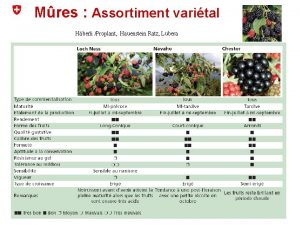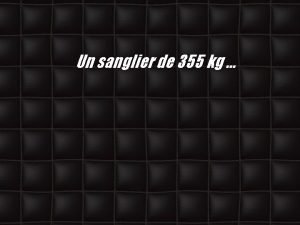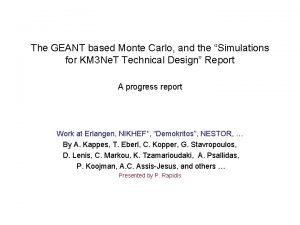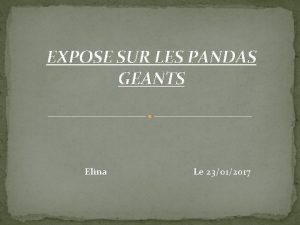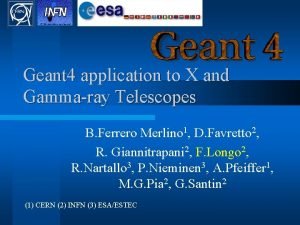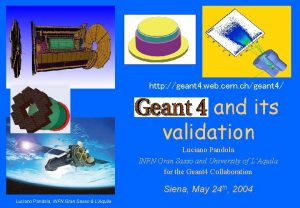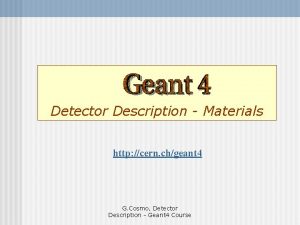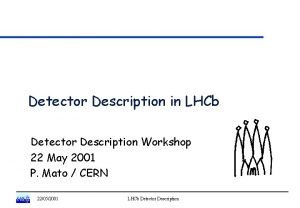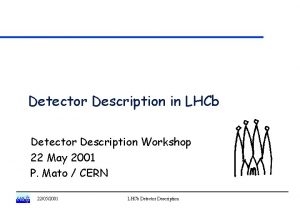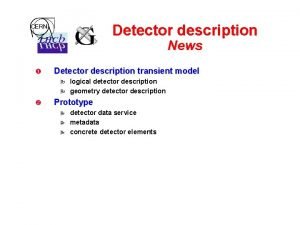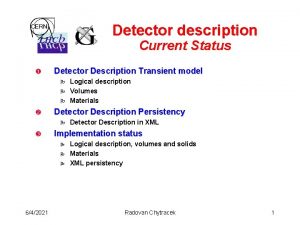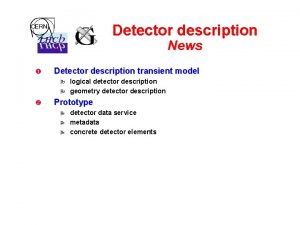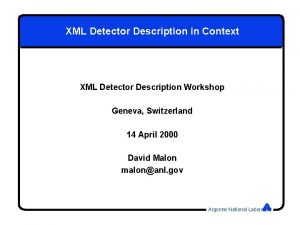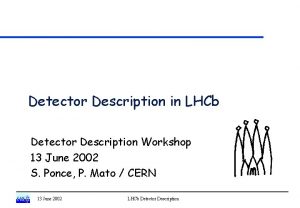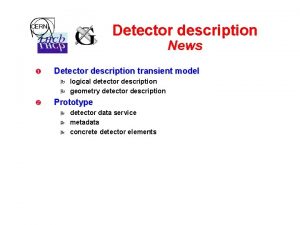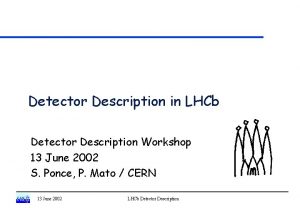Detector Description Materials http geant 4 cern ch




















- Slides: 20

Detector Description - Materials http: //geant 4. cern. ch

PART I Geant 4 system of units

System of Units (1) n Geant 4 has no default unit. To give a number, unit must be “multiplied” to the number. n for example: G 4 double width = 12. 5*m; G 4 double density = 2. 7*g/cm 3; n n n If no unit is specified, the internal G 4 unit will be used, but this is discouraged! Almost all commonly used units are available. The user can define new units. Refer to CLHEP: System. Of. Units. h Divide a variable by a unit you want to get: G 4 cout << d. E/Me. V << “ (Me. V)” << G 4 endl; 3

System of Units (2) n System of units are defined in CLHEP, based on: n n n millimetre (mm), nanosecond (ns), Mega-e. V (Me. V), positron charge (eplus) degree Kelvin (kelvin), the amount of substance (mole), luminous intensity (candela), radian (radian), steradian (steradian) All other units are computed from the basic ones In output, Geant 4 can choose the most appropriate unit to use. Just specify the category for the data (Length, Time, Energy, etc…): G 4 cout << G 4 Best. Unit(Step. Size, “Length”); Step. Size will be printed in km, m, mm or … fermi, depending on its value 4

System of Units (3) n New units can be defined directly as constants, or (suggested way) via G 4 Unit. Definition n n Example (mass thickness): n n n G 4 Unit. Definition ( name, symbol, category, value ) G 4 Unit. Definition (“grammpercm 2”, “g/cm 2”, “Mass. Thickness”, g/cm 2); The new category “Mass. Thickness” will be registered in the kernel in G 4 Units. Table To print the list of units: n n From the code G 4 Unit. Definition: : Print. Units. Table(); At run-time, as UI command: Idle> /units/list 5

PART II Definition of materials and compounds

Definition of Materials n Different kinds of materials can be defined: n n n isotopes elements molecules compounds <> G 4 Isotope <> G 4 Element <> G 4 Material and mixtures <> G 4 Material Attributes associated to materials: n density (mandatory), temperature, pressure, state (liquid, gas, etc. ) 7

Isotopes, Elements and Materials n G 4 Isotope and G 4 Element describe the properties of the nuclei and atoms: n n Atomic number, number of nucleons, mass of a mole, shell energies, etc. . . Cross-sections per atoms, etc… Elements are possibly built up by isotopes G 4 Material describes the macroscopic properties of the matter: n n n temperature, pressure, state, density Radiation length, absorption length, etc… Materials are built up by elements 8

G 4 Elements (1) n Isotopes can be assembled into elements G 4 Isotope (const G 4 String& G 4 int G 4 double n name, z, // number of atoms n, // number of nucleons a ); // mass of mole … building elements as follows: G 4 Element (const G 4 String& name, const G 4 String& symbol, // element symbol G 4 int n. Iso ); // # of isotopes G 4 Element: : Add. Isotope(G 4 Isotope* iso, // isotope G 4 double rel. Abund); // relative abundance 9

G 4 Elements (2) n Alternatively, if the element under consideration has the natural isotopic abundance, it can be defined using: G 4 Element(const G 4 String& name, //its name const G 4 String& symbol, //its symbol G 4 double Zeff, //atomic number G 4 double Aeff); //mass of mole n For instance: G 4 Element* el. Oxygen = new G 4 Element("Oxygen", symbol="O", z=8. , a=16*g/mole); 10

G 4 Elements (3) n Elements can also be defined using the internal Geant 4 database: #include "G 4 Nist. Manager. hh" [. . . ] G 4 Nist. Manager* man = G 4 Nist. Manager: : Instance(); // define elements G 4 Element* el. Carbon = man->Find. Or. Build. Element("C"); n To print information on a costituent element: G 4 cout << el. Carbon << G 4 endl; 11

Material: single element n Single-element materials can be defined in a quick way as follows: G 4 double density = 1. 390*g/cm 3; G 4 double a = 39. 95*g/mole; G 4 Material* l. Ar = new G 4 Material("liquid. Argon", z=18. , a, density); n n Materials composed by many elements (molecules or compounds) have to be defined through their constituent elements Prefer low-density material to vacuum 12

Material: molecule define elements n A Molecule is made of several elements (composition by number of atoms): a = 1. 01*g/mole; G 4 Element* el. H = new G 4 Element("Hydrogen", symbol="H", z=1. , a); a = 16. 00*g/mole; G 4 Element* el. O = new G 4 Element("Oxygen", symbol="O", z=8. , a); density = 1. 000*g/cm 3; G 4 Material* H 2 O = new G 4 Material("Water", density, ncomp=2); H 2 O->Add. Element(el. H, natoms=2); H 2 O->Add. Element(el. O, natoms=1); number of components 13

Material: compound define elements n Compound, made by several elements: composition by fraction of mass a = 14. 01*g/mole; G 4 Element* el. N = new G 4 Element(name="Nitrogen", symbol="N", z= 7. , a); a = 16. 00*g/mole; G 4 Element* el. O = new G 4 Element(name="Oxygen", symbol="O", z= 8. , a); density = 1. 290*mg/cm 3; G 4 Material* Air = new G 4 Material(name="Air", density, ncomponents=2); Air->Add. Element(el. N, 70. 0*per. Cent); Air->Add. Element(el. O, 30. 0*per. Cent); number of components 14

Material: mixture n Composition of compound materials G 4 Element* el. C = …; G 4 Material* Si. O 2 = …; G 4 Material* H 2 O = …; // define “carbon” element // define “quartz” material // define “water” material density = 0. 200*g/cm 3; G 4 Material* Aerog = new G 4 Material("Aerogel", density, ncomponents=3); Aerog->Add. Material(Si. O 2, fractionmass=62. 5*per. Cent); Aerog->Add. Material(H 2 O , fractionmass=37. 4*per. Cent); Aerog->Add. Element(el. C , fractionmass= 0. 1*per. Cent); n Mixtures could also be defined using their elemental mass composition (as described in the previous slide) 15

Material: NIST database n Materials can also be defined using the internal Geant 4 database, based on NIST. #include "G 4 Nist. Manager. hh" G 4 Nist. Manager* man = G 4 Nist. Manager: : Instance(); // define pure NIST materials G 4 Material* Cu = man->Find. Or. Build. Material("G 4_Cu"); // define NIST materials G 4 Material* H 2 O = man->Find. Or. Build. Material("G 4_WATER"); n The list of available material names is extended permanently. It can be accessed at run-time: Idle> /material/nist/list. Materials all or from the code G 4 Nist. Manager: : Instance()->List. Materials(“all”); 16

PART III A few examples and information

Example: define a gas n It may be necessary to specify temperature and pressure (d. E/dx computation affected). For density <10 mg/cm 3 the material is automatically considered a gas (k. State. Gas) G 4 double density = 27. *mg/cm 3; G 4 double temperature = 325. *kelvin; G 4 double pressure = 50. *atmosphere; G 4 Material* CO 2 = new G 4 Material(“Carbonic. Gas", density, ncomponents=2 k. State. Gas, temperature, pressure); CO 2 ->Add. Element(C, natoms = 1); CO 2 ->Add. Element(O, natoms = 2); 18

Example: define “vacuum” n Absolute vacuum does not exist. It is a gas at very low density (e. g. transparent to particles being tracked) Cannot define materials with r = 0 G 4 double atomic. Number = 1. ; G 4 double mass. Of. Mole = 1. 008*g/mole; G 4 double density = 1. e-25*g/cm 3; G 4 double temperature = 2. 73*kelvin; G 4 double pressure = 3. e-18*pascal; G 4 Material* Vacuum = new G 4 Material(“inter. Galactic", atomic. Number, mass. Of. Mole, density, k. State. Gas, temperature, pressure); 19

Print material information n To print information on a given user-defined G 4 Material: G 4 cout << Air << G 4 endl; or at run-time via the UI command Idle> /material/g 4/print. Material material. Name n To print the full list of user-defined materials: G 4 cout << *(G 4 Material: : Get. Material. Table()) << G 4 endl; 20
 Myrtillier géant
Myrtillier géant Renmap
Renmap Sanglier poids record
Sanglier poids record Plus grosse machine au monde
Plus grosse machine au monde Action geant
Action geant Geant computer
Geant computer Geant simulation
Geant simulation Geant 4
Geant 4 Fernand bachelard
Fernand bachelard Exposé panda
Exposé panda Geant 4
Geant 4 Geant 4
Geant 4 Pub geant
Pub geant Gate geant
Gate geant Pion geant
Pion geant Chenille brahmin
Chenille brahmin Cant stop the feeling trolls go noodle
Cant stop the feeling trolls go noodle Recognizing harmful and useful materials
Recognizing harmful and useful materials Natural materials and man made materials
Natural materials and man made materials Adopting materials
Adopting materials Direct materials budget with multiple materials
Direct materials budget with multiple materials
